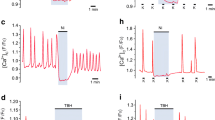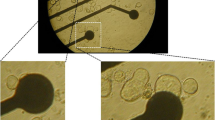Abstract
We describe here the construction and properties of a double-barrelled microelectrode (tip diameter 4–10 μm) which permits simultaneous measurements of PCO2 and pH, and which has a 90% response time of only one or a few seconds for a step change in PCO2. The fast response of the CO2-sensitive barrel is due to (i) the use of a PVC-gelled (tridodecylamine-containing) membrane solution which enables the construction of extremely short (≥ 4 μm), yet mechanically stable, membrane columns, and (ii) the presence of carbonic anhydrase in the filling solution. Recordings made in the pyramidal layer of area CA1 in rat hippocampal slices showed that the deviation in the acid direction of the basal interstitial pH (pH0) from that of the perfusion solution was attributable to a higher PCO2 level within the tissue. Most of the late acid shift evoked by stimulation of the Schaffer collaterals (5- to 20-s trains at 10 Hz) could also be explained on the basis of an accumulation of interstitial CO2 at a constant HCO −3 concentration. This conclusion was supported by the finding that inhibition of extracellular carbonic anhydrase activity by 10 μM benzolamide completely abolished the activity-induced fall in pH0, but not the increase in PCO2. The initial stimulus-induced alkalosis was accompanied by a slight decrease in PCO2 only, implying a parallel increase in the interstitial HCO −3 concentration. Benzolamide produced a dramatic enhancement of the early alkaline shift as well as of the simultaneous fall in PCO2. The latter effect of the drug unmasks a cellular CO2 sink that is induced by neuronal activity.
Similar content being viewed by others
References
Ammann D (1986) Ion-selective microelectrodes. Springer, Berlin Heidelberg New York
Andersen P (1990) Synaptic integration in hippocampal CA1 pyramids. Prog Brain Res 83:215–222
Bomsztyk K, Calalb MB (1986) A new microelectrode method for simultaneous measurement of pH and PCO2. Am J Physiol 251:F933-F937
Caflisch CR, Carter NW (1974) A micro pCO2 electrode. Anal Biochem 60:252–257
Chen JCT, Chesler M (1992) Modulation of extracellular pH by glutamate and GABA in rat hippocampal slices. J Neurophysiol 67:29–36
Chesler M (1990) The regulation and modulation of pH in the nervous system. Prog Neurobiol 34:401–427
Chesler M, Kaila K (1992) Modulation of pH by neuronal activity. Trends Neurosci 15:396–402
Coon RL, Lai NCJ, Kampine JP (1976) Evaluation of a dualfunction pH and PCO2 in vivo sensor. J Appl Physiol 40:625–629
Deitmer JW, Schlue W-R (1989) An inwardly directed electrogenic sodium-bicarbonate co-transport in leech glial cells. J Physiol 411:179–194
Endres W, Grafe P, Bostock H, Ten Bruggencate G (1986) Changes in extracellular pH during electrical stimulation of isolated vagus nerve. Neurosci Lett 64:201–205
Fencl V (1986) Acid-base balance in cerebral fluids. In: Cherniack NS, Widdicombe JG (eds) Handbook of physiology, section 3. The respiratory system, vol II. American Physiological Society, Bethesda, Md., pp 115–140
Fujii T, Baumgärtl H, Lübbers DW (1982) Limiting section thickness of guinea pig olfactory cortical slices studied from tissue pO2 values and electrical activities. Pflügers Arch 393:83–87
Funck RJJ, Morf WE, Schulthess P, Ammann D, Simon W (1982) Bicarbonate-sensitive liquid membrane electrodes based on neutral carriers for hydrogen ions. Anal Chem 54:423–429
Hansen AJ (1985) Effect of anoxia on ion distribution in the brain. Physiol Rev 65:101–148
Kaila K, Voipio J (1985) A simple method for dry bevelling of micropipettes used in the construction of ion-selective microelectrodes. J Physiol (Lond) 369:8 P
Kaila K, Saarikoski J, Voipio J (1990) Mechanism of action of GABA on intracellular pH and on surface pH in crayfish muscle fibres. J Physiol (Lond) 427:241–260
Kaila K, Paalasmaa P, Taira T, Voipio J (1992) pH transients due to monosynaptic activation of GABAA receptors in rat hippocampal slices. NeuroReport 3:105–108
Kaila K, Voipio J, Paalasmaa P, Pasternack M, Deisz RA (1993) The role of bicarbonate in GABAA receptor-mediated IPSPs in rat neocortical neurons. J Physiol (Lond) 464:273–289
Katsura K, Ekholm A, Asplund B, Siesjö BK (1991) Extracellular pH in the brain during ischemia: relationship to the severity of lactic acidosis. J Cereb Blood Flow Metab 11:597–599
Kraig RP, Cooper AJL (1986) Bicarbonate and ammonia changes in brain during spreading depression. Can J Physiol Pharmacol 65:1099–1104
Kraig RP, Ferreira-Filho CS, Nicholson C (1983) Alkaline and acid transients in cerebellar microenvironment. J Neurophysiol 49:831–850
Kraig RP, Pulsinelli WA, Plum F (1986) Carbonic acid buffer changes during complete brain ischemia. Am J Physiol 250:R 348-R 357
Lothman EW, Somjen GG (1975) Extracellular potassium activity, intracellular and extracellular potential responses in the spinal cord. J Physiol (Lond) 252:115–136
Ma Y (1990) A carbon dioxide air-gap microelectrode based on a neutral hydrogen ion exchanger pH microelectrode. Anal Biochem 186:74–77
Mostert IA, Morf WE, Simon W (1984) Optimization of a bicarbonate-selective liquid membrane electrode. Mikrochim Acta III:425–432
Mutch WAC, Hansen AJ (1984) Extracellular pH changes during spreading depression and cerebral ischemia: mechanisms of brain pH regulation. J Cereb Blood Flow Metab 4:17–27
Nicholson C, Phillips JM (1981) Ion diffusion modified by tortuosity and volume fraction in the extracellular microenvironment of the rat cerebellum. J Physiol (Lond) 321:225–257
Niedrach LW (1975) Bicarbonate ion electrode and sensor. U. S. Patent 3,898,147
Obrenovitch TP, Scheller D, Matsumoto T, Tegtmeier F, Höller M, Symon L (1990) A rapid redistribution of hydrogen ions is associated with depolarization and repolarization subsequent to cerebral ischemia reperfusion. J Neurophysiol 64:1125–1133
Oesch U, Simon W (1980) Life time of neutral carrier based ion-selective liquid-membrane electrodes. Anal Chem 52:692–700
Ponten U, Siesjö BK (1966) Gradients of CO2 tension in brain. Acta Physiol Scand 67:129–140
Pucacco LR, Carter NW (1978) An improved PCO2 microelectrode. Anal Biochem 90:427–434
Saarikoski J, Kaila K (1992) Simultaneous measurement of intracellular and extracellular carbonic anhydrase activity in intact muscle fibres. Pflügers Arch 421:357–363
Schiff SJ, Somjen GG (1987) The effect of graded hypoxia on the hippocampal slice: an in vitro model of the ischemic penumbra. Stroke 18:30–37
Schwartzkroin PA, Knowles WD (1983) Local interactions in the hippocampus. Trends Neurosci 6:88–92
Severinghaus JW, Bradley AF (1958) Electrodes for blood pO2 and PCO2 determination. J Appl Physiol 13:515–520
Siesjö BK (1961) A method for continuous measurement of the carbon dioxide tension on the cerebral cortex. Acta Physiol Scand 51:297–313
Siesjö BK (1985) Acid-base homeostasis in the brain: physiology, chemistry, and neurochemical pathology. Prog Brain Res 63:121–154
Stow RW, Bear RF, Randall BF (1957) Rapid measurement of the tension of carbon dioxide in blood. Arch Phys Med Rehabil 38:646–650
Voipio J, Pasternack M, Rydqvist B, Kaila K (1991) Effect of γ-aminobutyric acid on intracellular pH in the crayfish stretch-receptor neurone. J Exp Biol 156:349–361
Voipio J, Paalasmaa P, Taira T, Kaila K (1992) Electrode measurements of interstitial CO2 and pH transients associated with spreading depression in rat hippocampal slices (abstract). Eur J Neurosci Suppl. No. 5:241
Walz W (1989) pH shifts evoked by neuronal stimulation in slices of rat hippocampus. Can J Physiol Pharmacol 67:577–581
Weast RC (ed) (1989) CRC handbook of chemistry and physics, 69th edn. CRC Press, Boca Raton, Fla
Author information
Authors and Affiliations
Rights and permissions
About this article
Cite this article
Voipio, J., Kaila, K. Interstitial PCO2 and pH in rat hippocampal slices measured by means of a novel fast CO2/H+-sensitive microelectrode based on a PVC-gelled membrane. Pflugers Arch. 423, 193–201 (1993). https://doi.org/10.1007/BF00374394
Received:
Accepted:
Issue Date:
DOI: https://doi.org/10.1007/BF00374394




